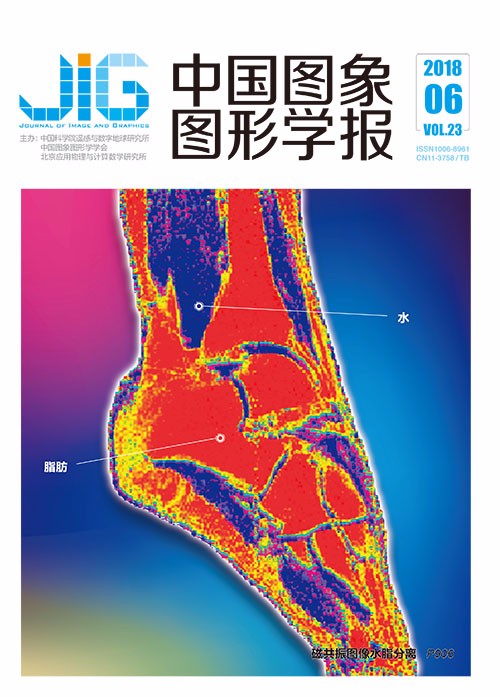
多特征融合与交替方向乘子法的行人再识别
摘 要
目的 由于行人图像分辨率差异、光照差异、行人姿态差异以及摄像机视角和成像质量差异等原因,导致同一行人在不同监控视频中的外观区别很大,给行人再识别带来了巨大挑战。为提高行人再识别的准确率,针对以上问题,提出一种基于多特征融合与交替方向乘子法的行人再识别算法。方法 首先利用图像增强算法对所有行人图像进行处理,减少因光照变化产生的影响,然后把处理后的图像进行非均匀分割,同时使用特定区域均值法提取行人图像的HSV和LAB颜色特征以及SILTP(scale invariant local ternary pattern)纹理特征和HOG(histogram of oriented gradient)特征,融合多种特征得到行人图像对的整体与局部相似度度量函数并结合产生相似度函数,最后使用交替方向乘子优化算法更新出最优的测度矩阵实现行人再识别。结果 在VIPeR、CUHK01、CUHK03和GRID这4个数据集上进行实验,其中VIPeR、CUHK01和GRID 3个数据集Rank1(排名第1的搜索结果即为待查询人的比率)分别达到51.5%、48.7%和21.4%,CUHK03 手动裁剪和检测器检测数据集Rank1分别达到62.40%和55.05%,识别率有了显著提高,具有实际应用价值。结论 提出的多特征融合与交替方向乘子优化算法,能够很好地描述行人特征,迭代更新出来的测度矩阵能够很好地表达行人之间的距离信息,较大幅度地提高了识别率。该方法适用于大多数应用场景下的行人再识别。尤其是针对复杂场景下静态图像行人再识别问题,在存在局部遮挡、光照差异和姿态差异的情况下也能保持较高的识别正确率。
关键词
Person re-identification based on multi-feature fusion and alternating direction method of multipliers
Qi Meibin, Wang Cichun, Jiang Jianguo, Li Ji(School of Computer and Information, Hefei University of Technology, Hefei 230009, China) Abstract
Objective Person re-identification is an extremely challenging problem and has practical application value. It plays an important role in video surveillance systems because it can reduce human efforts in searching for a target from a large number of videos. This topic has gained increasing interest in computer vision. Nowadays, person re-identification algorithms have been applied in criminal investigation, where the interference of passers-by can be eliminated to help the police find final suspects. However, differences in color, illumination, posture, imaging quality, as well as low-resolution of the captured frames cause large appearance variance across multiple cameras; thus, person re-identification remains a significant problem. An algorithm for person re-identification, which is based on multi-feature fusion and alternating direction method of multipliers, is proposed to improve the accuracy of person re-identification. Method First, the original images are processed by the image enhancement algorithm to reduce the impact of illumination changes. This enhancement algorithm is committed to provide an image that is close to human visual characteristics. Then, the method of non-uniform segmentation that processes images is used. The method uses a sub-window size of 10-by-10 pixels with 5-pixel overlapping steps to obtain the local information of the pedestrian image. Meanwhile, the method uses the specific region mean method to divide the pedestrian image into five blocks. Specifically, depending on the difference of the expression ability of the legs and torso, these parts are divided into three blocks and two blocks, respectively. Then, the second and third blocks take the maximum operation, whereas the other blocks perform the mean operation because the second and third blocks are less affected by ambient noise compared with the other blocks. We also extract the HSV and LAB color features of the processed images, a texture feature of scale-invariant local ternary pattern and a shape feature of histogram of oriented gradient. The existing pedestrian re-identification algorithms generally consider the matching between local regions to eliminate the gap information between blocks. The combination of the global and local methods can effectively solve this problem. The proposed algorithm uses the multi-feature fusion method to combine the global and local information, which combines the global and local similarity measurement function of the related person, to obtain the final similarity function. Finally, the optimal distance measurement matrix is updated by the alternating direction method of multipliers, and the final similarities between each pair are obtained to conduct the re-identification. Result The proposed method is demonstrated on four public benchmark datasets including VIPeR, CUHK01, CUHK03, and GRID. Each dataset has its own characteristics. The proposed method achieves a 51.5% rank 1 (represents the accurately matched pair) on VIPeR benchmark and 48.7% and 21.4% on CUHK01 and GRID benchmarks, respectively. Rank 5 (represents the expectation of the matches at rank 5) is more than 80% on the VIPeR datasets and more than 70% on the CUHK01 datasets. The proposed method achieved 62.40% and 55.05% rank 1 identification rates with the labeled bounding boxes and automatically detected bounding boxes, respectively, thereby indicating that the method outperforms that of local maximal occurrence with an improvement of 10.2% for the labeled setting and 8.8% for the detected setting. The proposed method significantly improves the recognition rate and has a practical application value. Conclusion The experimental results show that the proposed method can express the image information of pedestrians effectively. Furthermore, the effectiveness of our algorithm stems from the non-uniform segmentation and the specific mean method, which reduces the influence of ambient noise, increases robustness to occlusion, and is more flexible in handling pose variation. The updated distance measure matrix can express the information of the distance between pedestrians and improve the recognition rate effectively. This method is applicable to person re-identification in most scenarios, especially for static image-based person re-identification in complex scenes. This method can maintain high recognition accuracy even in the presence of local occlusion, illumination difference, and pose or viewpoint difference.
Keywords
person re-identification multi-feature fusion non-uniform segmentation HOG feature specific region mean method alternating direction method of multipliers
|



 中国图象图形学报 │ 京ICP备05080539号-4 │ 本系统由
中国图象图形学报 │ 京ICP备05080539号-4 │ 本系统由